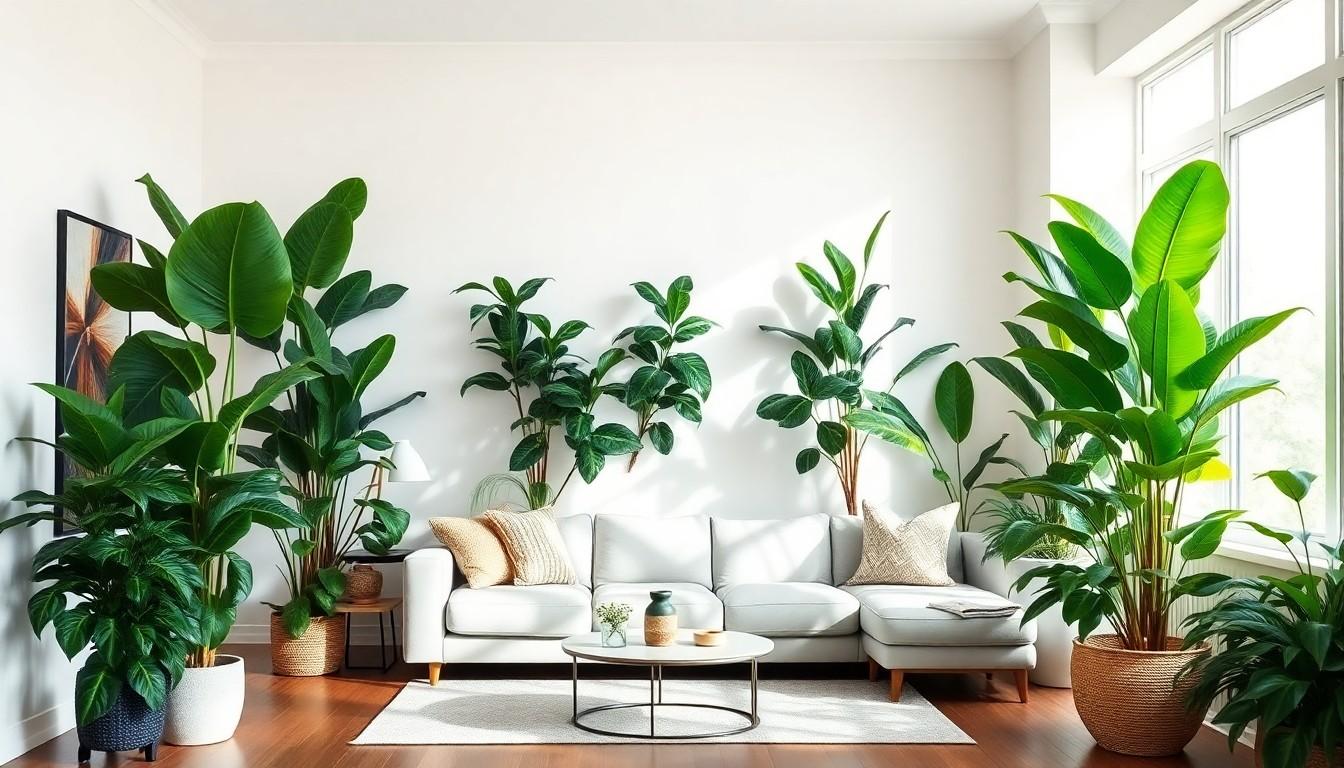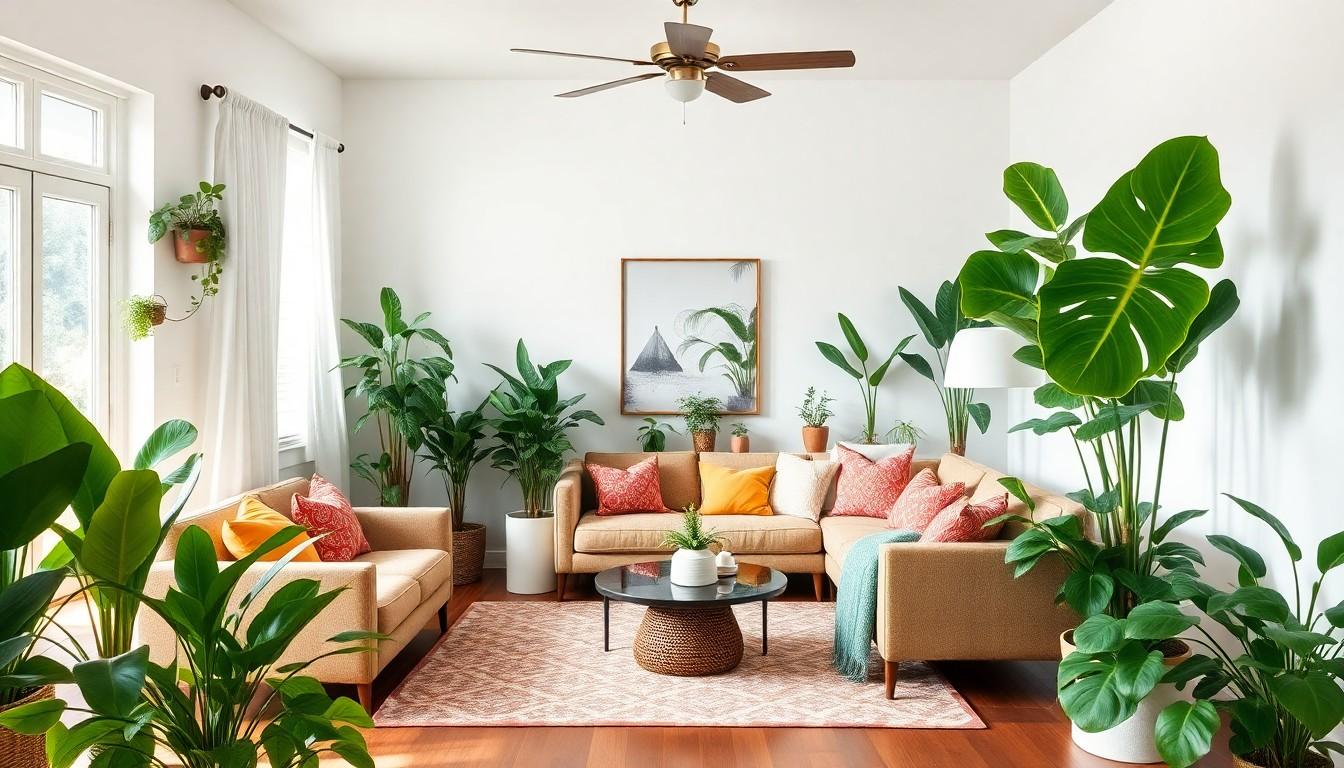Phone:
(701)814-6992
Physical address:
6296 Donnelly Plaza
Ratkeville, Bahamas.

Imagine transforming your home into a lush oasis without needing a degree in botany or a sun-drenched backyard. Low light large indoor plants are the unsung heroes of the plant world, perfect for those who want the beauty of greenery without the hassle of constant sunlight. They thrive in dim corners and can turn even the gloomiest of rooms into a vibrant retreat.
Low light large indoor plants fit perfectly in dimly lit spaces. Their adaptability allows them to thrive with minimal sunlight. Many options like the snake plant, pothos, and rubber tree offer substantial foliage, enhancing room ambiance.
These plants contribute to improved air quality, promoting a healthier indoor environment. They naturally filter airborne toxins, making them beneficial choices for homes and offices alike. With their lush greenery, they provide a calming effect that positively influences mood.
Caring for these plants requires minimal effort. Regular watering and occasional dusting of leaves suffice for maintaining health and vitality. Choosing pots that complement interior decor further enhances their aesthetic appeal.
When placed strategically, large indoor plants can act as natural dividers, adding both privacy and style. Living rooms, bedrooms, and office spaces all benefit from the presence of these vibrant plants.
Individuals looking to create a nature-inspired atmosphere will find low light large indoor plants an ideal solution. Whether one opts for a tall fiddle leaf fig or a wide monstera, options abound for any space.
Overall, these plants not only beautify homes but also offer functional benefits. Selecting the right variety brings forth both visual dynamics and a sense of tranquility. Their versatility ensures that they accommodate various stylistic preferences while thriving in low light conditions.

Low light large indoor plants offer numerous benefits that enhance living spaces. They contribute to a healthier indoor atmosphere while providing visual interest.
Plants like snake plants and pothos effectively filter airborne toxins, improving air quality. These natural air purifiers absorb carbon dioxide and release oxygen, promoting a healthier environment. Research shows that indoor plants can reduce pollutants such as formaldehyde and benzene, making spaces safer for inhabitants. Regular presence of these plants in homes or offices leads to decreased sickness and an overall enhancement in well-being. Their easy care needs make air quality maintenance simple—the addition of these plants ensures cleaner air while requiring minimal effort.
Large indoor plants introduce a vibrant touch to any decor. Their lush foliage creates visual interest, enhancing the overall aesthetic of a room. Varieties like the fiddle leaf fig and monstera serve as eye-catching focal points, easily complementing various interior styles. Incorporating these plants brings life to otherwise dull areas, brightening up corners and elevating design appeal. Creative placement offers versatility, transforming spaces into inviting havens. The calming presence of greenery contributes to positive mood effects, making everyday living more enjoyable.
Numerous large indoor plants thrive in low light, making them perfect additions to any space. These varieties not only enhance aesthetics but also improve air quality.
The fiddle leaf fig stands out with its large, glossy leaves. Growing up to 6 feet tall, this tree creates a striking focal point in rooms. While it prefers bright indirect light, it can adapt to lower light conditions. Once established, this plant needs watering when the top inch of soil dries out. Regular dusting keeps those impressive leaves clean and healthy.
Snake plants embody resilience and adaptability, thriving in various light conditions. This plant can grow up to 4 feet tall, featuring tall, upright leaves with variegated edges. Low maintenance makes it suitable for busy individuals. Watering occurs every couple of weeks, allowing the soil to dry completely between sessions. Besides its striking appearance, the snake plant excels at filtering indoor air pollutants.
ZZ plants offer shiny, dark green leaves that can brighten any dim space. Growing between 2 to 3 feet tall, this plant flourishes in low-light environments. It thrives on neglect, needing minimal care. Watering every few weeks suffices, especially in winter months. Its ability to tolerate drought and low light maintains its appeal for beginners and seasoned plant owners alike.
Caring for low light large indoor plants involves simple routines that lead to successful growth. Specific practices ensure these plants thrive in dim environments.
Watering these plants requires attention to moisture levels. A general rule is to check the top inch of soil; if it feels dry, it’s time to water. Most low light large indoor plants prefer slightly moist conditions but can tolerate some dryness. Overwatering can cause root rot, so allowing the soil to dry out between waterings benefits the plants. Depending on the environment, plant watering may vary, but typically every 1 to 2 weeks suffices.
Low light large indoor plants thrive in indirect sunlight. They typically flourish in spaces with bright but filtered light, making them suitable for corners or near windows with sheer curtains. While they can tolerate very low light, prolonged exposure to darkness may hinder growth. Arranging such plants away from direct sunlight prevents leaf scorch while maintaining their vibrancy. Assessing the specific needs of each plant variety boosts their health and appearance.
Choosing the right soil mix supports healthy growth. A well-draining potting mix typically delivers the best results. Incorporating peat moss or perlite improves aeration and drainage, essential for preventing overwatering issues. Fertilization, while not overly rigorous, should occur during the growing season, usually from spring to fall. Using a balanced, water-soluble fertilizer every 4 to 6 weeks provides essential nutrients for growth.
Low light large indoor plants can face several pests and problems, affecting their health and appearance. Identifying these issues early ensures effective intervention.
Common pests include spider mites, aphids, and mealybugs. Spider mites appear as tiny webbing on leaves. Aphids cluster on new growth, sucking sap and causing distortion. Mealybugs, resembling small cotton clumps, settle on stems and leaves, leading to wilting. Regularly inspecting plants for these signs helps catch infestations before they spread.
Effective solutions involve maintaining plant health and applying treatments promptly. Neem oil acts as a natural pesticide, targeting pests without harming plants. Isolating affected plants prevents infestations from spreading. Cleaning leaves with damp cloths removes dust and potential pests, ensuring better air circulation. Using insecticidal soap is another option for severe infestations. Regularly checking watering practices prevents overwatering, which can attract pests. Establishing a routine inspection every few weeks contributes to healthier plants.
Low light large indoor plants are a fantastic choice for anyone looking to enhance their living spaces. They not only add a touch of nature but also improve air quality and promote a serene atmosphere. With minimal care requirements and a variety of stunning options, these plants can transform any dim area into a vibrant oasis.
By selecting the right plants and following simple care tips, anyone can enjoy the beauty and benefits these greenery giants provide. Whether it’s a snake plant or a fiddle leaf fig, these plants are sure to elevate both decor and well-being. Embracing low light large indoor plants can lead to a healthier and more inviting home environment.